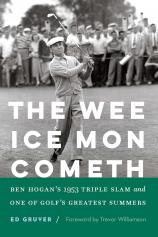The Wee Ice Mon Cometh: Ben Hogan's 1953 Triple Slam and One of Golf's Greatest Summers
Review
The Wee Ice Mon Cometh: Ben Hogan's 1953 Triple Slam and One of Golf's Greatest Summers
In the world of golf, great names continue to be fondly remembered and exalted. 2024 saw Scottie Scheffler rise to the #1 ranking and win multiple tournaments on the PGA Tour, including the Players Championship, the Masters, the FedEx Cup and the Olympic gold medal. This comes at a time when professional golf is divided into two groups: the traditional PGA and the LIV Tour, a Saudi Arabian-funded enterprise that seeks to change the way that golf is traditionally played.
Scheffler’s outstanding season recalls the accomplishments of golfing legends Bobby Jones, Jack Nicklaus, Arnold Palmer and Tiger Woods. Ed Gruver’s excellent book, THE WEE ICE MON COMETH, is a reminder of an achievement that many consider the greatest in golf history. In 1953, Ben Hogan won the Triple Crown: the Masters, the U.S. Open and the British Open. The only other golfer to win three majors in one year was Tiger, but his victories occurred in a different era and under far less difficult circumstances.
"THE WEE ICE MON COMETH accurately portrays an important but often overlooked athletic accomplishment in magnificent fashion. It is a wonderful addition to any sports library."
Gruver opens his account of the 1953 season with a brief but important biographical note about Hogan. Unlike modern golfers who enjoy major sponsorships and financial backing, Hogan started his career with a car and a miniscule bank account. Following years of struggle and a break for service in World War II, he finally found success in golf nearly 10 years after turning pro. It was not until 1946 and 1948 that he won major titles (the U.S. Open and the PGA Championship).
Then, in early 1949, while driving from Arizona to Texas, Hogan and his wife, Valerie, were nearly killed in an automobile accident. Gruver deftly uses this information as background for those perhaps less familiar with Hogan’s career. It seamlessly sets the stage for the 1953 championship season that would end with Hogan receiving a ticker-tape parade in New York City following his return from Great Britain.
For each of the three tournaments involved in Hogan's Triple Crown, Gruver pens an introductory chapter that addresses the status of the golfing world that year. As the 1952 season concluded, 40-year-old Hogan was facing questions regarding his game. He had failed to win either the Masters or the U.S. Open. Although he wasn’t too old to be a professional athlete, his car accident placed great physical limitations on his golfing abilities.
Discussing the 1953 season, Gruver begins with some informative history regarding Augusta National Golf Club. In 1930, Bobby Jones won the open and amateur championships in both the United States and Great Britain. He then retired from competitive golf with the dream of building and creating a golf course in his home state of Georgia. He hired architect Alister MacKenzie to replicate what he considered to be the essence of the great courses he had played in the US and the UK. Each year in April, golfers travel to Augusta for a storied and revered tournament.
Hogan began his preparation for the 1953 Masters with weeks of practice at the course. Modern professional golfers have weekly events with million-dollar purses. In Hogan’s era, there were not that many tournaments, so he could focus on an event such as the Masters. There is a full account of his victory at Augusta and the additional fact that he told his wife that he would enter the British Open if he won the U.S. Open in June.
And win it he did. The 1953 U.S. Open was held in Oakmont, Pennsylvania. It was a difficult and lengthy course made even more so for Hogan because at that time it concluded with 36 holes of golf on the final day. His injuries from the accident meant additional preparation for a round of golf, which included soaking his legs and wrapping them with Ace bandages. Once again, Gruver sets the scene admirably and recounts Hogan’s victory. He led after every round and joined a small group of four-time winners there.
The final section is the trip to England and his triumph at the British Open at Carnoustie. Once again, Gruver furnishes readers with history, personalities and a detailed account of Hogan’s preparation and play as he secured a victory that made him a sports legend.
THE WEE ICE MON COMETH accurately portrays an important but often overlooked athletic accomplishment in magnificent fashion. It is a wonderful addition to any sports library.
Reviewed by Stuart Shiffman on October 5, 2024
The Wee Ice Mon Cometh: Ben Hogan's 1953 Triple Slam and One of Golf's Greatest Summers
- Publication Date: October 1, 2024
- Genres: History, Nonfiction, Sports
- Hardcover: 232 pages
- Publisher: University of Nebraska Press
- ISBN-10: 1496238982
- ISBN-13: 9781496238986



